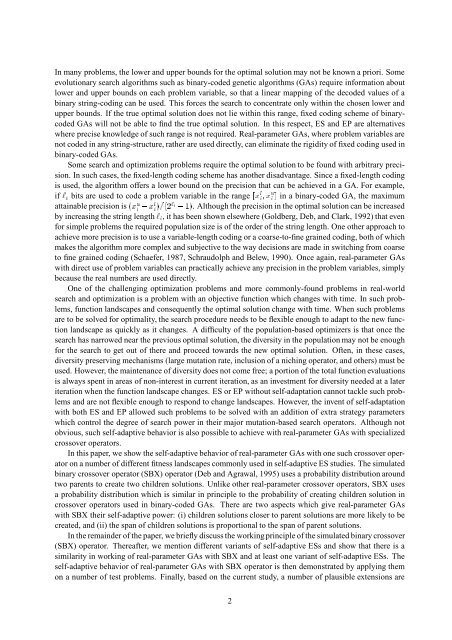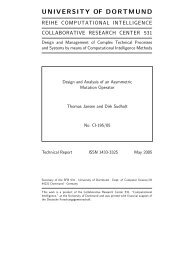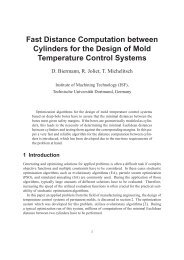Self-Adaptive Genetic Algorithms with Simulated Binary Crossover
Self-Adaptive Genetic Algorithms with Simulated Binary Crossover
Self-Adaptive Genetic Algorithms with Simulated Binary Crossover
You also want an ePaper? Increase the reach of your titles
YUMPU automatically turns print PDFs into web optimized ePapers that Google loves.
In many problems, the lower and upper bounds for the optimal solution may not be known a priori. Some<br />
evolutionary search algorithms such as binary-coded genetic algorithms (GAs) require information about<br />
lower and upper bounds on each problem variable, so that a linear mapping of the decoded values of a<br />
binary string-coding can be used. This forces the search to concentrate only <strong>with</strong>in the chosen lower and<br />
upper bounds. If the true optimal solution does not lie <strong>with</strong>in this range, fixed coding scheme of binarycoded<br />
GAs will not be able to find the true optimal solution. In this respect, ES and EP are alternatives<br />
where precise knowledge of such range is not required. Real-parameter GAs, where problem variables are<br />
not coded in any string-structure, rather are used directly, can eliminate the rigidity of fixed coding used in<br />
binary-coded GAs.<br />
Some search and optimization problems require the optimal solution to be found <strong>with</strong> arbitrary precision.<br />
In such cases, the fixed-length coding scheme has another disadvantage. Since a fixed-length coding<br />
is used, the algorithm offers a lower bound on the precision that can be achieved in a GA. For example,<br />
if`ibits are used to code a problem variable in the range[xli;xui]in a binary-coded GA, the maximum<br />
attainable precision is(xui?xli)=(2`i?1). Although the precision in the optimal solution can be increased<br />
by increasing the string length`i, it has been shown elsewhere (Goldberg, Deb, and Clark, 1992) that even<br />
for simple problems the required population size is of the order of the string length. One other approach to<br />
achieve more precision is to use a variable-length coding or a coarse-to-fine grained coding, both of which<br />
makes the algorithm more complex and subjective to the way decisions are made in switching from coarse<br />
to fine grained coding (Schaefer, 1987, Schraudolph and Belew, 1990). Once again, real-parameter GAs<br />
<strong>with</strong> direct use of problem variables can practically achieve any precision in the problem variables, simply<br />
because the real numbers are used directly.<br />
One of the challenging optimization problems and more commonly-found problems in real-world<br />
search and optimization is a problem <strong>with</strong> an objective function which changes <strong>with</strong> time. In such problems,<br />
function landscapes and consequently the optimal solution change <strong>with</strong> time. When such problems<br />
are to be solved for optimality, the search procedure needs to be flexible enough to adapt to the new function<br />
landscape as quickly as it changes. A difficulty of the population-based optimizers is that once the<br />
search has narrowed near the previous optimal solution, the diversity in the population may not be enough<br />
for the search to get out of there and proceed towards the new optimal solution. Often, in these cases,<br />
diversity preserving mechanisms (large mutation rate, inclusion of a niching operator, and others) must be<br />
used. However, the maintenance of diversity does not come free; a portion of the total function evaluations<br />
is always spent in areas of non-interest in current iteration, as an investment for diversity needed at a later<br />
iteration when the function landscape changes. ES or EP <strong>with</strong>out self-adaptation cannot tackle such problems<br />
and are not flexible enough to respond to change landscapes. However, the invent of self-adaptation<br />
<strong>with</strong> both ES and EP allowed such problems to be solved <strong>with</strong> an addition of extra strategy parameters<br />
which control the degree of search power in their major mutation-based search operators. Although not<br />
obvious, such self-adaptive behavior is also possible to achieve <strong>with</strong> real-parameter GAs <strong>with</strong> specialized<br />
crossover operators.<br />
In this paper, we show the self-adaptive behavior of real-parameter GAs <strong>with</strong> one such crossover operator<br />
on a number of different fitness landscapes commonly used in self-adaptive ES studies. The simulated<br />
binary crossover operator (SBX) operator (Deb and Agrawal, 1995) uses a probability distribution around<br />
two parents to create two children solutions. Unlike other real-parameter crossover operators, SBX uses<br />
a probability distribution which is similar in principle to the probability of creating children solution in<br />
crossover operators used in binary-coded GAs. There are two aspects which give real-parameter GAs<br />
<strong>with</strong> SBX their self-adaptive power: (i) children solutions closer to parent solutions are more likely to be<br />
created, and (ii) the span of children solutions is proportional to the span of parent solutions.<br />
In the remainder of the paper, we briefly discuss the working principle of the simulated binary crossover<br />
(SBX) operator. Thereafter, we mention different variants of self-adaptive ESs and show that there is a<br />
similarity in working of real-parameter GAs <strong>with</strong> SBX and at least one variant of self-adaptive ESs. The<br />
self-adaptive behavior of real-parameter GAs <strong>with</strong> SBX operator is then demonstrated by applying them<br />
on a number of test problems. Finally, based on the current study, a number of plausible extensions are<br />
2








